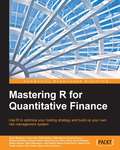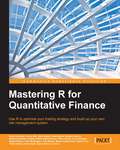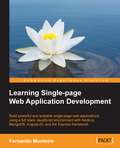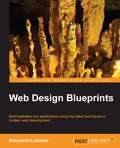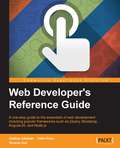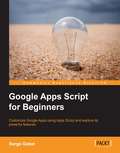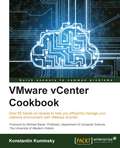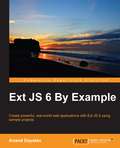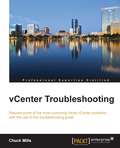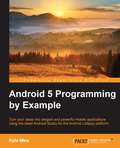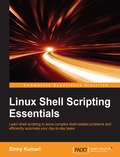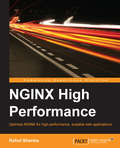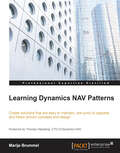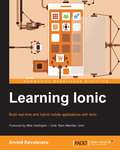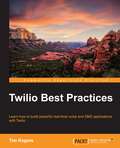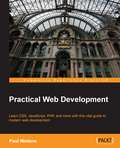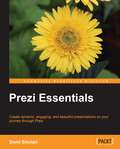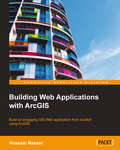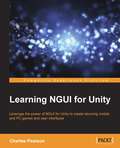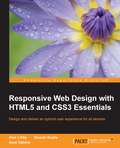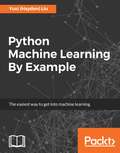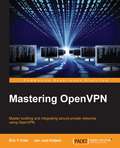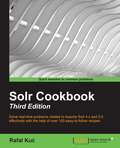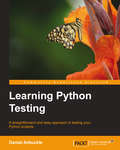- Table View
- List View
Mastering R for Quantitative Finance
by Edina Berlinger Ferenc Illes Tamas Vadasz<P><P>Use R to optimize your trading strategy and build up your own risk management system <P><P>About This Book <P><P>Learn to manipulate, visualize, and analyze a wide range of financial data with the help of built-in functions and programming in R <P><P>Understand the concepts of financial engineering and create trading strategies for complex financial instruments <P><P>Explore R for asset and liability management and capital adequacy modeling <P><P>Who This Book Is For <P><P>This book is intended for those who want to learn how to use R's capabilities to build models in quantitative finance at a more advanced level. If you wish to perfectly take up the rhythm of the chapters, you need to be at an intermediate level in quantitative finance and you also need to have a reasonable knowledge of R.
Mastering R for Quantitative Finance
by Edina Berlinger Ferenc IllésThis book is intended for those who want to learn how to use R's capabilities to build models in quantitative finance at a more advanced level. If you wish to perfectly take up the rhythm of the chapters, you need to be at an intermediate level in quantitative finance and you also need to have a reasonable knowledge of R.
Learning Single-page Web Application Development
by Fernando MonteiroThis book is aimed at web developers who are familiar with frontend technologies like JavaScript, HTML, and CSS, and modern tools like Bower, Yeoman, and Grunt.
Web Design Blueprints
by Benjamin LagroneBuild websites and applications using the latest techniques in modern web development About This Book * Create amazing modern day applications that run seamlessly across multiple platforms * Implement multiple methodologies by creating different apps with dynamic features * This unique project-based guide will help you build your own websites efficiently Who This Book Is For This book is a must-have for web developers who want to stay on top of the latest trends in web app and site development. If you are a web developer who is already familiar with HTML, CSS, and functional JavaScript, and you want to learn the latest trends in web development, this is the book for you. What You Will Learn * Find out how to create responsive websites * Create websites using the principals of Flat design * Create deep-dive sites using parallax scrolling * Discover how to use Ajax in single-page applications * Create responsive navigation with CSS and JavaScript * Create responsive padding with the box model property In Detail The book delivers simple instructions on how to design and build modern Web using the latest trends in web development. You will learn how to design responsive websites, created with modern Flat User Interface design patterns, build deep-scrolling websites with parallax 3D effects, and roll-your-own single-page applications. Finally, you'll work through an awesome chapter that combines them all. Each chapter features actual lines of code that you can apply right away. Style and Approach Using real-world examples, Web Design Blueprints presents practical how-to projects for site enhancements, with a light-hearted, easy-to-understand tone. This book has individual projects that cumulate until you finally build a super-project at the end, using all the skills learned
Web Developer's Reference Guide
by Joshua Johanan Ricardo Zea Talha KhanA one-stop guide to the essentials of web development including popular frameworks such as jQuery, Bootstrap, AngularJS, and Node.js About This Book * Understand the essential elements of HTML, CSS, and JavaScript, including how and when to use them * Walk through three of the best and most popular web development frameworks - jQuery, Bootstrap, and AngularJS * References for any function you will need in your day-to-day web development Who This Book Is For This book is perfect for beginners but more advanced web developers will also benefit. Laid out so you can refer to as much or as little as you need to, with this book you can exhaustively explore essential concepts for modern web developers. What You Will Learn * Explore detailed explanations of all the major HTML elements and attributes, illustrated with examples * Take a deep dive into CSS properties and functions and master their usage * Find clear, concise descriptions of JavaScript syntax and expressions * Recognize various JavaScript design patterns and learn the basics of JavaScript object-orientated programming * Implement the latest ECMAScript 6 for client-side scripting in your web applications * Discover new ways to develop your website's front end quickly and easily using Bootstrap * Write JavaScript extensibly using jQuery-JavaScript's feature-rich library * Delve into the key Node.js modules used in JavaScript server-side programming * Access AngularJS 's important modules, controllers, directives, and services quickly In Detail This comprehensive reference guide takes you through each topic in web development and highlights the most popular and important elements of each area. Starting with HTML, you will learn key elements and attributes and how they relate to each other. Next, you will explore CSS pseudo-classes and pseudo-elements, followed by CSS properties and functions. This will introduce you to many powerful and new selectors. You will then move on to JavaScript. This section will not just introduce functions, but will provide you with an entire reference for the language and paradigms. You will discover more about three of the most popular frameworks today--Bootstrap, which builds on CSS, jQuery which builds on JavaScript, and AngularJS, which also builds on JavaScript. Finally, you will take a walk-through Node.js, which is a server-side framework that allows you to write programs in JavaScript. Style and approach This book is an easy-to-follow, comprehensive reference guide. Each topic, function, or element is listed methodically along with parameters, return values, and descriptions. Examples are also included to help you put the concepts to use quickly in the real world.
Google Apps Script for Beginners
by Serge GabetThis book is a simple step-by-step, example-oriented guide with a focus on providing the practical skills necessary to develop and customize apps with Apps Script. If you are an application developer with no knowledge of App Script, and would like to learn to build apps using Google Apps script from scratch, then this book is for you. Basic JavaScript knowledge is required.
VMware vCenter Cookbook
by Konstantin KuminskyIf you are a system administrator who has some experience with virtualization and already uses VMware vCenter, but wishes to learn more, then this is the book for you. If you are looking for tips or shortcuts for common administration tasks as well as workarounds for pain points in vSphere administration, you'll find this guide useful.
Ext JS 6 By Example
by Anand DayalanCreate powerful, real-world web applications with Ext JS 6 using sample projects About This Book * Explore, debug, and get practical by extending the sample projects, including a sample RESTful API project in Ext JS 6 * Gain a quick and easy understanding through working source code and get an explanation of multiple cool sample projects * A project-based guide to help you get your hands on real-world applications Who This Book Is For If you're a front web developer who is looking to learn a new JavaScript framework, or if you already know about Ext JS and are looking for a practical resource with multiple example projects to get expert-level knowledge in Ext JS, then this guide will be a great resource for you. A basic understanding of HTML, CSS, and JavaScript is expected. What You Will Learn * Install Ext JS Sencha Cmd 6 and debugging tools such as Illumination, App Inspector, and Sencha Fiddle * Understand and apply the core concepts and querying capabilities of Ext JS 6 * Dive deep into powerful components such as Grid, Data View, Trees, and different kinds of charts including 3D charts as well as Bar, Area, Pie, Line charts * Discover how an Ext JS 6 application communicates with the server side through Data Packages such as Stores and Proxies * Discover how to create responsive web applications and client-side routing * Acquire and implement knowledge on accessibility, localization, and the drag-and-drop and theming capabilities of Ext JS 6 In Detail Ext JS is one of the most famous JavaScript frameworks used to create rich interactive web applications using techniques such as Ajax, DHTML, JSON, and DOM scripting. It provides a complete rich set of GUI controls, has an excellent API for AJAX and REST, and helps users to organize their code with Model View ViewModel (MVVM) or the MVC architecture, and supports two-way data binding, responsive layouts, responsive design, and more. It is an extensive, one-stop-shop to build an JavaScript RIA application. This book starts with a clear step-by-step installation guide for Ext JS 6 and the additional tools required for development on both Mac and Windows operating systems. It then covers the core concepts and fundamentals of Ext JS 6. We move on to focus on multiple basic GUI controls such as buttons, message boxes, and menus, and a sample project that covers the fundamental and basic GUI controls. You'll also learn how to design a form with form fields such as a text field, number field, date picker, label, and radio button, and learn about form validation. We proceed to show you how to organize your code using the MVVM application architecture, and you'll then jump into advanced controls such as Grids, Trees, Data Views, and Charts. You'll also learn about the API required for AJAX and REST communication, and learn all need to know about Ext JS Data Packages. A working RESTful API sample project is included to help you explore the Data Packages. Finally, we end with a discussion on responsive design, theming your application, and the available plugins. Style and approach This is an example-based guide to help you develop rich Internet applications using Ext JS 6. Most of the chapters start with a particular concept and code example, and end with a cool sample project that uses the concepts learned in the chapter.
vCenter Troubleshooting
by Chuck MillsThe book is designed for the competent vCenter administrator or anyone who is responsible for the vSphere environment. It can be used as a guide by vSphere architects and VMware consultants for a successful vSphere solution. You should have good knowledge and an understanding of core elements and applications of the vSphere environment.
Android 5 Programming by Example
by Kyle MewIf you have a great idea for a mobile app, and some familiarity with Java, or a similar procedural programming language, then all you need is this book to turn your idea into a reality.
Linux Shell Scripting Essentials
by Sinny KumariLearn shell scripting to solve complex shell-related problems and to efficiently automate your day-to-day tasks About This Book * Familiarize yourself with the terminal by learning about powerful shell features * Automate tasks by writing shell scripts for repetitive work * Packed with easy-to-follow, hands-on examples to help you write any type of shell script with confidence Who This Book Is For This book is aimed at administrators and those who have a basic knowledge of shell scripting and who want to learn how to get the most out of writing shell scripts. What You Will Learn * Write effective shell scripts easily * Perform search operations and manipulate large text data with a single shell command * Modularize reusable shell scripts by creating shell libraries * Redirect input, output, and errors of a command or script execution to other streams * Debug code with different shell debugging techniques to make your scripts bug-free * Manage processes, along with the environment variables needed to execute them properly * Execute and embed other languages in your scripts * Manage creation, deletion, and search operations in files In Detail Shell scripting is a quick method to prototype complex applications or problems. Shell scripts are a collection of commands to automate tasks, usually those for which the user has a repeated need, when working on Linux-based systems. Using simple commands or a combination of them in a shell can solve complex problems easily. This book starts with the basics, including essential commands that can be executed on Linux systems to perform tasks within a few nanoseconds. You'll learn to use outputs from commands and transform them to show the data you require. Discover how to write shell scripts easily, execute script files, debug, and handle errors. Next, you'll explore environment variables in shell programming and learn how to customize them and add a new environment. Finally, the book walks you through processes and how these interact with your shell scripts, along with how to use scripts to automate tasks and how to embed other languages and execute them. Style and approach This book is a pragmatic guide to writing efficient shell programs, complete with hands-on examples and tips.
NGINX High Performance
by Rahul SharmaSystem administrators, developers, and engineers looking for ways to achieve maximum performance from NGINX will find this book beneficial. If you are looking for solutions such as how to handle more users from the same system or load your website pages faster, then this is the book for you.
Canvas Cookbook
by Bhushan Purushottam JoshiOver 80 simple but creative and structured recipes to explore the capabilities of HTML5 Canvas About This Book * Develop simple to advanced recipes of your own, and ultimately produce a great application * Discover a better way to use HTML5 Canvas, JavaScript, and CSS * Put your creative instincts to use in your day-to-day interface developments Who This Book Is For The book is intended for readers with a preliminary knowledge of JavaScript and CSS. Whether you're a beginner or expert in this technology, the book provides recipes to help you build your own application, presentation, or game. What You Will Learn * Draw basic shapes such as lines, arcs, curves, and text using the coordinate system * Learn about the animation cycle and use it to animate shapes * Grasp the knowledge required to create particles and use them * Give various effects to images and videos and also use them in animations * Discover the use of event listeners to make recipes interactive and to handle events through event handlers * Create good presentation graphics with graphs and charts * Learn all about 3D development, from building 3D objects to animating them * Convert your knowledge into a complete working game * Understand the interoperability and deployment of recipes on different browsers and on different devices In Detail With the growing popularity of HTML5 Canvas, this book offers tailored recipes to help you develop portable applications, presentations, and games. The recipes are simple yet creative and build on each other. At every step, the book inspires the reader to develop his/her own recipe. From basic to advanced, every aspect of Canvas API has been covered to guide readers to develop their own application, presentation, or game. Style and approach All the recipes are sequential and cover the basic and advanced concepts of Canvas. Every recipe is as simple as possible without compromising creativity
Learning Dynamics NAV Patterns: Create Solutions That Are Easy To Maintain, Quick To Upgrade, And Follow Proven Concepts And Designs
by Mark BrummelCreate solutions that are easy to maintain, quick to upgrade, and follow proven concepts and designs About This Book * Design software that is maintainable outside the ecosystem of their creators * Ensure quality by following patterns that have been proved to work * Over two dozen practical Architectural and Design patterns Who This Book Is For Learning Dynamics NAV Patterns is intended for developers, architects, (technical) consultants, and application managers. You may have very little or no knowledge about NAV patterns, but you should be acquainted with programming. What You Will Learn * Apply object-oriented practices to C/AL programming * Structure your application to avoid merge conflicts * Refactor legacy code and avoid anti-patterns * Design decision trees to decide when to use which patterns * Clone codes and their application in Dynamics NAV * Make your application extensible by creating predefined hooks and facades In Detail Microsoft Dynamics NAV is a complete ERP system, which also contains a robust set of development tools to support customization and enhancement. These include an object designer for each of the seven application object types, a business application oriented programming language with .NET interface capability, a compiler, a debugger, and programming testing language support. Learning Dynamics NAV Patterns will guide you through the NAV way of solving problems. This book will first introduce you to patterns and the software architecture of the NAV and then help you to build an example application. Then, it walks you through the details of architectural patterns, design patterns, and implementation patterns. This book will also talk about anti-patterns and handling legacy code. Finally, it teaches you to build solutions using patterns. Proven patterns and best practices will help you create better solutions that are easy to maintain in larger teams across several locations. It will guide you through combining abstract patterns using easy-to-understand examples and will help you decide which patterns to use in which scenarios. Style and approach This book explains the concepts of patterns, code structuring, and object-oriented concepts in a way that is easy to understand for Dynamics NAV specialists through practical examples.
Learning Ionic
by Arvind Ravulavaru<P><P>Key Features <P><P>Create hybrid mobile applications by combining the capabilities of Ionic, Cordova, and AngularJS <P><P>Reduce the time to market your application using Ionic, that helps in rapid application development <P><P>Detailed code examples and explanations, helping you get up and running with Ionic quickly and easily <P><P>Book Description <P><P>With the growth of the start-up market, the time it takes to market your app ideas is crucial. Developing apps using each platform specific format is time consuming and will put you behind in the rat race. Enter the hybrid mobile space: using knowledge of web technologies, one can transform their ideas into complete apps in no time and distribute them to a wide market of people. <P><P>Apps developed using web technologies need to have a robust, testable, and scalable client side JavaScript framework. This is where a beautiful CSS framework named Ionic meets AngularJS to provide an elegant, robust, testable, and scalable framework enabling the building of hybrid mobile apps. <P><P>With this book, you will learn hybrid mobile application development using Ionic. This book uses Cordova 5.0.0, Ionic CLI 1.5.0 & Ionic 1.0.0 to explain the concepts and build apps. <P><P>To begin with, the book helps you understand where Ionic fits in today's world. Then you will deep dive into Ionic CSS components, Ionic-Angular directives, and services. You will also examine theming Ionic apps using the built in SCSS setup. <P><P>Next, you will learn to build an Ionic client for a secure REST API, where you will implement user authentication and token-based development. Cordova and ngCordova will be explored and you will learn how you can integrate device specific features like a camera and Bluetooth with an Ionic app. You will wrap up the book by building a messaging app, which will deal with integrating REST API as well as device features. <P><P>By the end of this book you will be able to develop a hybrid mobile application from start to finish. <P><P>What you will learn <P><P>Learn how a hybrid mobile application works <P><P>Familiarize yourself with Cordova and see how it fits into hybrid mobile application development <P><P>Seamlessly work with Ionic CSS components and Ionic-Angular <P><P>JavaScript components like directives and services <P><P>Learn how to theme Ionic apps, as well as customize components using Ionic SCSS support <P><P>Develop an app that builds a client for a Secure REST API using <P><P>Ionic & Angular <P><P>Develop a real-time chat app using Firebase, that consumes ngCordova <P><P>Learn how to generate a device specific installer for an Ionic app using Ionic CLI as well as Ionic Cloud services
Twilio Best Practices
by Tim RogersIf you have experience with at least one programming language and are looking to integrate Twilio into your applications, then this book is for you.
Practical Web Development
by Paul WellensThis book is perfect for beginners who want to get started and learn the web development basics, but also offers experienced developers a web development roadmap that will help them to extend their capabilities.
Prezi Essentials
by Domi SinclairIf you want to learn Prezi, and specifically design within Prezi, this is the book for you. Perhaps you already know a bit about Prezi but have never used it, or perhaps you have used Prezi before but want to learn how to incorporate your own custom design elements. In either case, this book will get you up and running quickly. It would be helpful to have a bit of familiarity with basic design concepts and the use of Prezi, but prior experience is not essential.
Building Web Applications with ArcGIS
by Hussein NasserIf you are a GIS user or a web programmer, this book is for you. This book is also intended for all those who have basic web development knowledge with no prior experience of ArcGIS and are keen on venturing into the world of ArcGIS technology. The book will equip you with the skills to comfortably start your own ArcGIS web development project.
Learning NGUI for Unity
by Charles PearsonIf you are a Unity 3D developer who wants to create an effective and user-friendly GUI using NGUI for Unity, then this book is for you. Prior knowledge of C# scripting is expected; however, no knowledge of NGUI is required.
Responsive Web Design with HTML5 and CSS3 Essentials
by Alex Libby Gaurav Gupta Asoj TalesraDesign and deliver an optimal user experience for all devices About This Book * Get to grips with the core functionality of RWD through examples * Discover how to make layouts, content and media flexible, and explore why a content-first approach is more effective * Maximize the performance of your web pages so that they work across all browsers and devices irrespective of the screen size Who This Book Is For This book is for web designers who are familiar with HTML and CSS, and want to begin with responsive web design. Web development experience and knowledge of HTML5, CSS3 is assumed. What You Will Learn * Explore various layout options * Understand what can be achieved in the browser, without the use of third-party tools * Executing media queries to benefit responsive designs * Understand the basics of responsive workflow and boilerplate frameworks * Improve performance of responsive web design * Maintain compatibility across various browsers In Detail Responsive web design (RWD) is a web design approach aimed at crafting sites to provide an optimal viewing and interaction experience--providing easy reading and navigation with minimum resizing, panning, and scrolling--and all of this across a wide range of devices from desktop computer monitors to mobile phones. Responsive web design is becoming more important as the amount of mobile traffic now accounts for more than half of the Internet's total traffic. This book will give you in depth knowledge about the basics of responsive web design. You will embark on a journey of building effective responsive web pages that work across a range of devices, from mobile phones to smart TVs, with nothing more than standard markup and styling techniques. You'll begin by getting an understanding of what RWD is and its significance to the modern web. Building on the basics, you'll learn about layouts and media queries. Following this, we'll dive into creating layouts using grid based templates. We'll also cover the important topic of performance management, and discover how to tackle cross-browser challenges. Style and approach This is a practical example-based book which will delve into various elements and benefits of a responsive web design. It will help you understand the essential skills needed to create responsive web sites and guide you through the basics of building responsive web pages for any device. The topics are a blend of theoretical and practical essentials which will assist you to explore more about responsive web design.
Python Machine Learning By Example: Implement Machine Learning Algorithms And Techniques To Build Intelligent Systems, 2nd Edition
by Yuxi Hayden LiuTake tiny steps to enter the big world of data science through this interesting guide About This Book • Learn the fundamentals of machine learning and build your own intelligent applications • Master the art of building your own machine learning systems with this example-based practical guide • Work with important classification and regression algorithms and other machine learning techniques Who This Book Is For This book is for anyone interested in entering the data science stream with machine learning. Basic familiarity with Python is assumed. What You Will Learn • Exploit the power of Python to handle data extraction, manipulation, and exploration techniques • Use Python to visualize data spread across multiple dimensions and extract useful features • Dive deep into the world of analytics to predict situations correctly • Implement machine learning classification and regression algorithms from scratch in Python • Be amazed to see the algorithms in action • Evaluate the performance of a machine learning model and optimize it • Solve interesting real-world problems using machine learning and Python as the journey unfolds In Detail Data science and machine learning are some of the top buzzwords in the technical world today. A resurging interest in machine learning is due to the same factors that have made data mining and Bayesian analysis more popular than ever. This book is your entry point to machine learning. This book starts with an introduction to machine learning and the Python language and shows you how to complete the setup. Moving ahead, you will learn all the important concepts such as, exploratory data analysis, data preprocessing, feature extraction, data visualization and clustering, classification, regression and model performance evaluation. With the help of various projects included, you will find it intriguing to acquire the mechanics of several important machine learning algorithms – they are no more obscure as they thought. Also, you will be guided step by step to build your own models from scratch. Toward the end, you will gather a broad picture of the machine learning ecosystem and best practices of applying machine learning techniques. Through this book, you will learn to tackle data-driven problems and implement your solutions with the powerful yet simple language, Python. Interesting and easy-to-follow examples, to name some, news topic classification, spam email detection, online ad click-through prediction, stock prices forecast, will keep you glued till you reach your goal. Style and approach This book is an enticing journey that starts from the very basics and gradually picks up pace as the story unfolds. Each concept is first succinctly defined in the larger context of things, followed by a detailed explanation of their application. Every concept is explained with the help of a project that solves a real-world problem, and involves hands-on work—giving you a deep insight into the world of machine learning. With simple yet rich language—Python—you will understand and be able to implement the examples with ease.
Mastering OpenVPN
by Jan Just Keijser Eric F CristMaster building and integrating secure private networks using OpenVPN About This Book * Discover how to configure and set up a secure OpenVPN * Enhance user experience by using multiple authentication methods * Delve into better reporting, monitoring, logging, and control with OpenVPN Who This Book Is For If you are familiar with TCP/IP networking and general system administration, then this book is ideal for you. Some knowledge and understanding of core elements and applications related to Virtual Private Networking is assumed. What You Will Learn * Identify different VPN protocols (IPSec, PPTP, OpenVPN) * Build your own PKI and manage certificates * Deploy your VPN on various devices like PCs, mobile phones, tablets, and more * Differentiate between the routed and bridged network * Enhance your VPN with monitoring and logging * Authenticate against third-party databases like LDAP or the Unix password file * Troubleshoot an OpenVPN setup that is not performing correctly In Detail Security on the internet is increasingly vital to both businesses and individuals. Encrypting network traffic using Virtual Private Networks is one method to enhance security. The internet, corporate, and "free internet" networks grow more hostile every day. OpenVPN, the most widely used open source VPN package, allows you to create a secure network across these systems, keeping your private data secure. The main advantage of using OpenVPN is its portability, which allows it to be embedded into several systems. This book is an advanced guide that will help you build secure Virtual Private Networks using OpenVPN. You will begin your journey with an exploration of OpenVPN, while discussing its modes of operation, its clients, its secret keys, and their format types. You will explore PKI: its setting up and working, PAM authentication, and MTU troubleshooting. Next, client-server mode is discussed, the most commonly used deployment model, and you will learn about the two modes of operation using "tun" and "tap" devices. The book then progresses to more advanced concepts, such as deployment scenarios in tun devices which will include integration with back-end authentication, and securing your OpenVPN server using iptables, scripting, plugins, and using OpenVPN on mobile devices and networks. Finally, you will discover the strengths and weaknesses of the current OpenVPN implementation, understand the future directions of OpenVPN, and delve into the troubleshooting techniques for OpenVPN. By the end of the book, you will be able to build secure private networks across the internet and hostile networks with confidence. Style and approach An easy-to-follow yet comprehensive guide to building secure Virtual Private Networks using OpenVPN. A progressively complex VPN design is developed with the help of examples. More advanced topics are covered in each chapter, with subjects grouped according to their complexity, as well as their utility.
Solr Cookbook - Third Edition
by Rafał KućThis book is for intermediate Solr Developers who are willing to learn and implement Pro-level practices, techniques, and solutions. This edition will specifically appeal to developers who wish to quickly get to grips with the changes and new features of Apache Solr 5.
Learning Python Testing
by Daniel ArbuckleThis book is ideal if you want to learn about the testing disciplines and automated testing tools from a hands-on, conversational guide. You should already know Python and be comfortable with Python 3.
